Blockchain Applications and Transformations in Supply Chain Management
VerifiedAdded on 2023/01/23
|19
|5004
|35
Report
AI Summary
This report provides a comprehensive analysis of blockchain technology's implementation in supply chain management. It begins with an executive summary and introduction that highlight the importance of blockchain in enhancing transaction security and database integrity within the supply chain. The report delves into a literature review and explains the blockchain theory, followed by an examination of issues persistent in current supply chain systems, such as data accessibility and vulnerabilities. It then proposes blockchain as a solution, detailing its implications, including the use of smart contracts and track-and-trace features. The report further explores applications of the technology, the ways blockchain transforms supply chain management, its benefits, and disadvantages. The report also provides an assessment of the blockchain technology and its application in supply chain environments.
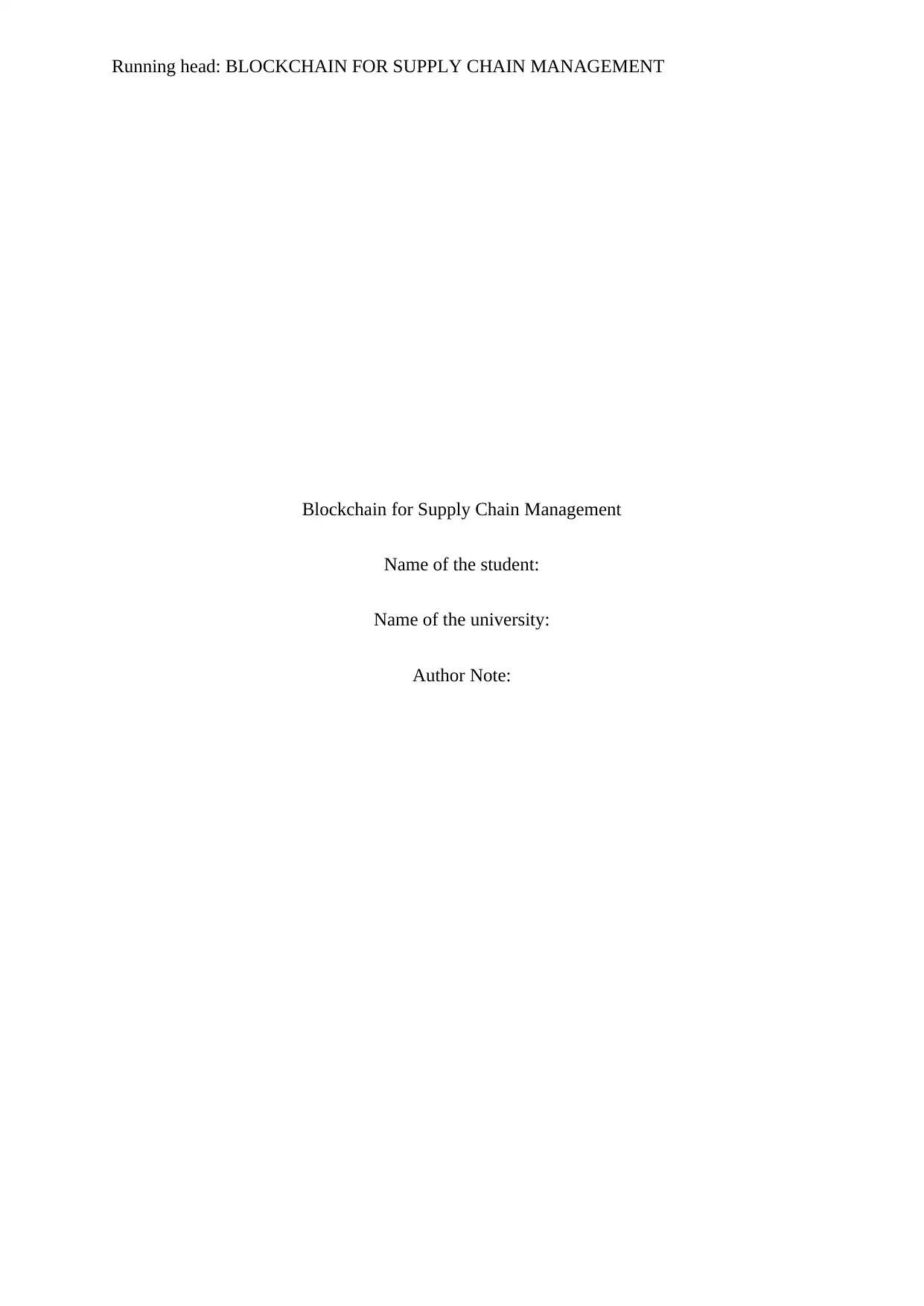
Running head: BLOCKCHAIN FOR SUPPLY CHAIN MANAGEMENT
Blockchain for Supply Chain Management
Name of the student:
Name of the university:
Author Note:
Blockchain for Supply Chain Management
Name of the student:
Name of the university:
Author Note:
Paraphrase This Document
Need a fresh take? Get an instant paraphrase of this document with our AI Paraphraser
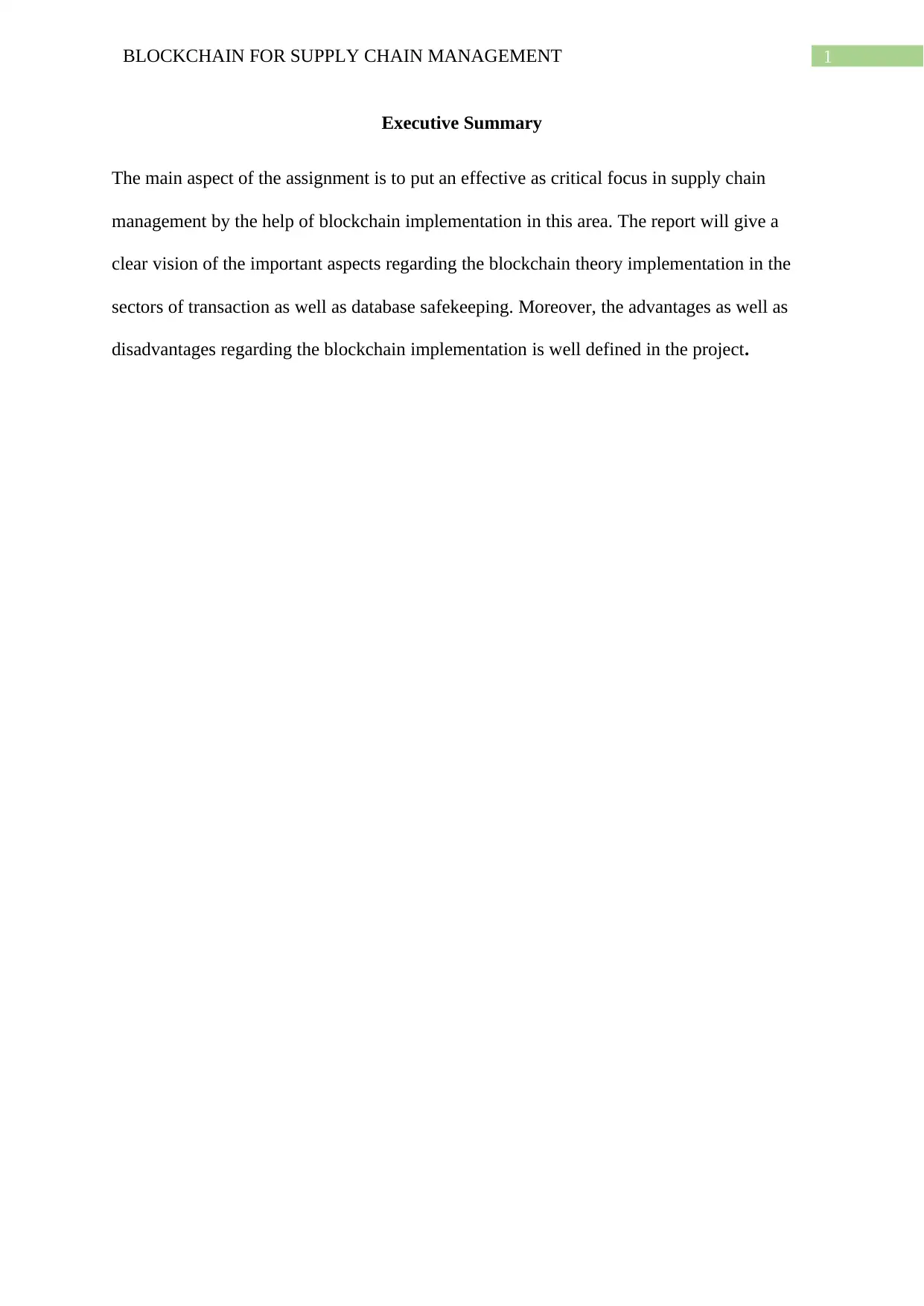
1BLOCKCHAIN FOR SUPPLY CHAIN MANAGEMENT
Executive Summary
The main aspect of the assignment is to put an effective as critical focus in supply chain
management by the help of blockchain implementation in this area. The report will give a
clear vision of the important aspects regarding the blockchain theory implementation in the
sectors of transaction as well as database safekeeping. Moreover, the advantages as well as
disadvantages regarding the blockchain implementation is well defined in the project.
Executive Summary
The main aspect of the assignment is to put an effective as critical focus in supply chain
management by the help of blockchain implementation in this area. The report will give a
clear vision of the important aspects regarding the blockchain theory implementation in the
sectors of transaction as well as database safekeeping. Moreover, the advantages as well as
disadvantages regarding the blockchain implementation is well defined in the project.
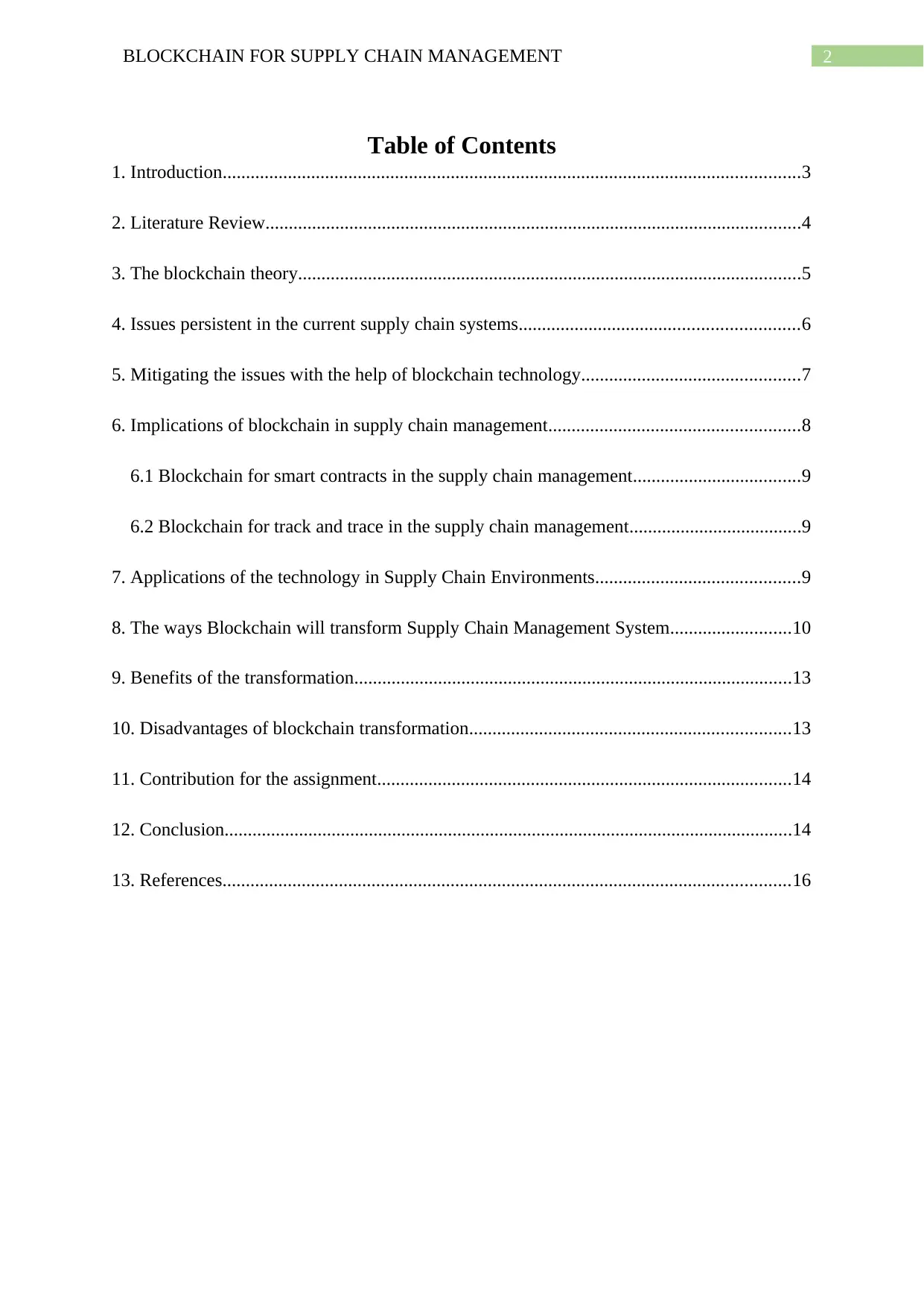
2BLOCKCHAIN FOR SUPPLY CHAIN MANAGEMENT
Table of Contents
1. Introduction............................................................................................................................3
2. Literature Review...................................................................................................................4
3. The blockchain theory............................................................................................................5
4. Issues persistent in the current supply chain systems............................................................6
5. Mitigating the issues with the help of blockchain technology...............................................7
6. Implications of blockchain in supply chain management......................................................8
6.1 Blockchain for smart contracts in the supply chain management....................................9
6.2 Blockchain for track and trace in the supply chain management.....................................9
7. Applications of the technology in Supply Chain Environments............................................9
8. The ways Blockchain will transform Supply Chain Management System..........................10
9. Benefits of the transformation..............................................................................................13
10. Disadvantages of blockchain transformation.....................................................................13
11. Contribution for the assignment.........................................................................................14
12. Conclusion..........................................................................................................................14
13. References..........................................................................................................................16
Table of Contents
1. Introduction............................................................................................................................3
2. Literature Review...................................................................................................................4
3. The blockchain theory............................................................................................................5
4. Issues persistent in the current supply chain systems............................................................6
5. Mitigating the issues with the help of blockchain technology...............................................7
6. Implications of blockchain in supply chain management......................................................8
6.1 Blockchain for smart contracts in the supply chain management....................................9
6.2 Blockchain for track and trace in the supply chain management.....................................9
7. Applications of the technology in Supply Chain Environments............................................9
8. The ways Blockchain will transform Supply Chain Management System..........................10
9. Benefits of the transformation..............................................................................................13
10. Disadvantages of blockchain transformation.....................................................................13
11. Contribution for the assignment.........................................................................................14
12. Conclusion..........................................................................................................................14
13. References..........................................................................................................................16
⊘ This is a preview!⊘
Do you want full access?
Subscribe today to unlock all pages.

Trusted by 1+ million students worldwide
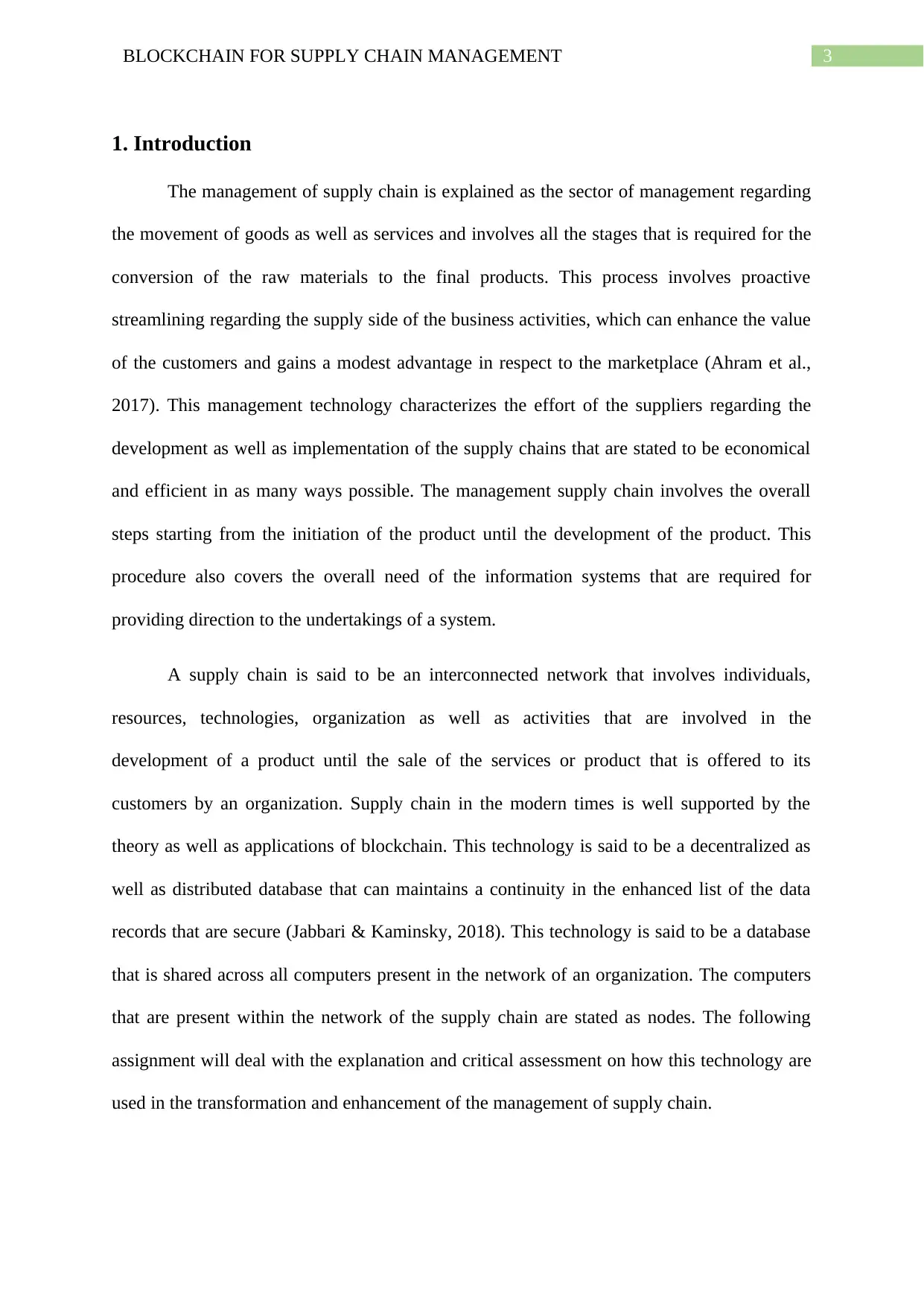
3BLOCKCHAIN FOR SUPPLY CHAIN MANAGEMENT
1. Introduction
The management of supply chain is explained as the sector of management regarding
the movement of goods as well as services and involves all the stages that is required for the
conversion of the raw materials to the final products. This process involves proactive
streamlining regarding the supply side of the business activities, which can enhance the value
of the customers and gains a modest advantage in respect to the marketplace (Ahram et al.,
2017). This management technology characterizes the effort of the suppliers regarding the
development as well as implementation of the supply chains that are stated to be economical
and efficient in as many ways possible. The management supply chain involves the overall
steps starting from the initiation of the product until the development of the product. This
procedure also covers the overall need of the information systems that are required for
providing direction to the undertakings of a system.
A supply chain is said to be an interconnected network that involves individuals,
resources, technologies, organization as well as activities that are involved in the
development of a product until the sale of the services or product that is offered to its
customers by an organization. Supply chain in the modern times is well supported by the
theory as well as applications of blockchain. This technology is said to be a decentralized as
well as distributed database that can maintains a continuity in the enhanced list of the data
records that are secure (Jabbari & Kaminsky, 2018). This technology is said to be a database
that is shared across all computers present in the network of an organization. The computers
that are present within the network of the supply chain are stated as nodes. The following
assignment will deal with the explanation and critical assessment on how this technology are
used in the transformation and enhancement of the management of supply chain.
1. Introduction
The management of supply chain is explained as the sector of management regarding
the movement of goods as well as services and involves all the stages that is required for the
conversion of the raw materials to the final products. This process involves proactive
streamlining regarding the supply side of the business activities, which can enhance the value
of the customers and gains a modest advantage in respect to the marketplace (Ahram et al.,
2017). This management technology characterizes the effort of the suppliers regarding the
development as well as implementation of the supply chains that are stated to be economical
and efficient in as many ways possible. The management supply chain involves the overall
steps starting from the initiation of the product until the development of the product. This
procedure also covers the overall need of the information systems that are required for
providing direction to the undertakings of a system.
A supply chain is said to be an interconnected network that involves individuals,
resources, technologies, organization as well as activities that are involved in the
development of a product until the sale of the services or product that is offered to its
customers by an organization. Supply chain in the modern times is well supported by the
theory as well as applications of blockchain. This technology is said to be a decentralized as
well as distributed database that can maintains a continuity in the enhanced list of the data
records that are secure (Jabbari & Kaminsky, 2018). This technology is said to be a database
that is shared across all computers present in the network of an organization. The computers
that are present within the network of the supply chain are stated as nodes. The following
assignment will deal with the explanation and critical assessment on how this technology are
used in the transformation and enhancement of the management of supply chain.
Paraphrase This Document
Need a fresh take? Get an instant paraphrase of this document with our AI Paraphraser
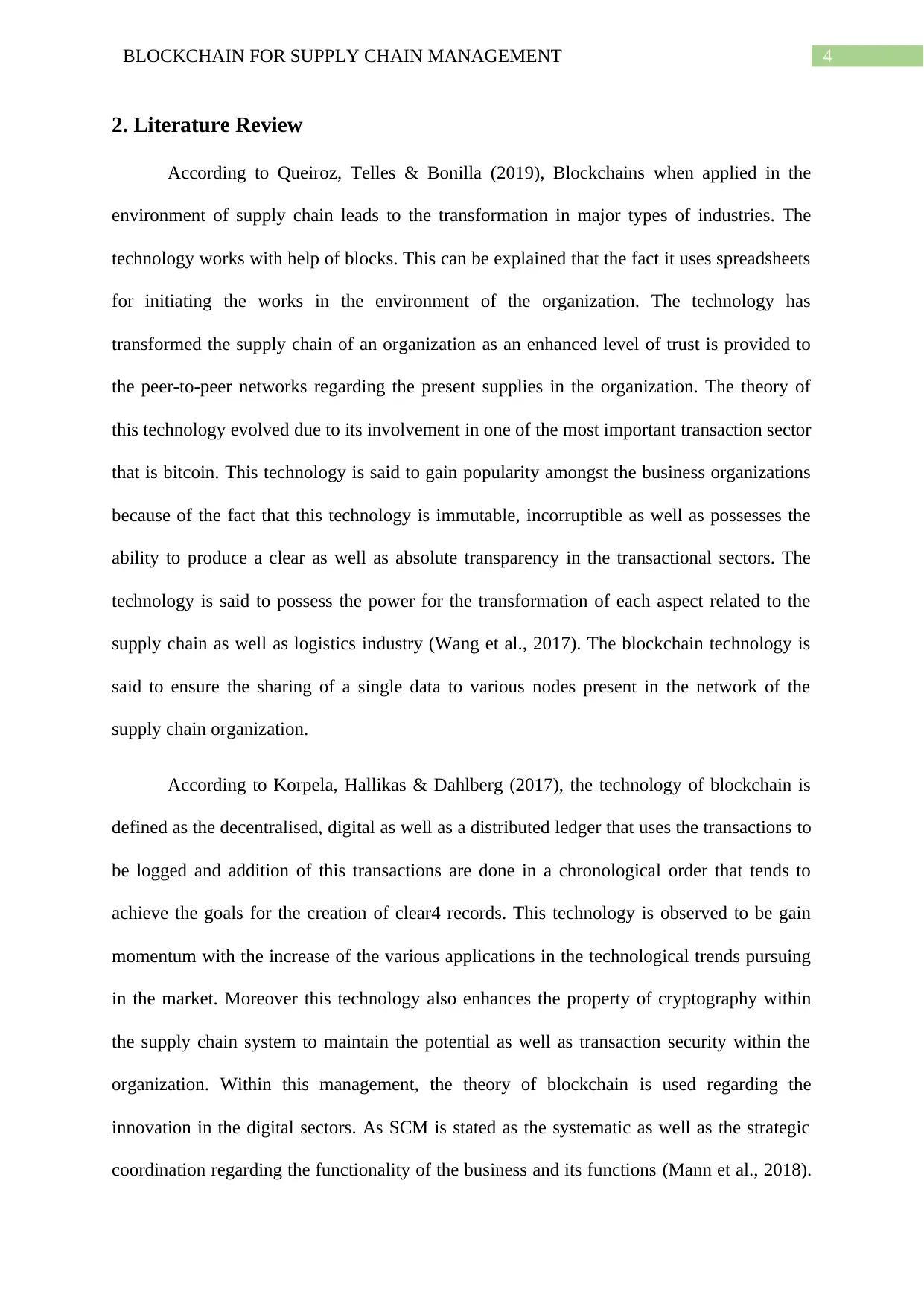
4BLOCKCHAIN FOR SUPPLY CHAIN MANAGEMENT
2. Literature Review
According to Queiroz, Telles & Bonilla (2019), Blockchains when applied in the
environment of supply chain leads to the transformation in major types of industries. The
technology works with help of blocks. This can be explained that the fact it uses spreadsheets
for initiating the works in the environment of the organization. The technology has
transformed the supply chain of an organization as an enhanced level of trust is provided to
the peer-to-peer networks regarding the present supplies in the organization. The theory of
this technology evolved due to its involvement in one of the most important transaction sector
that is bitcoin. This technology is said to gain popularity amongst the business organizations
because of the fact that this technology is immutable, incorruptible as well as possesses the
ability to produce a clear as well as absolute transparency in the transactional sectors. The
technology is said to possess the power for the transformation of each aspect related to the
supply chain as well as logistics industry (Wang et al., 2017). The blockchain technology is
said to ensure the sharing of a single data to various nodes present in the network of the
supply chain organization.
According to Korpela, Hallikas & Dahlberg (2017), the technology of blockchain is
defined as the decentralised, digital as well as a distributed ledger that uses the transactions to
be logged and addition of this transactions are done in a chronological order that tends to
achieve the goals for the creation of clear4 records. This technology is observed to be gain
momentum with the increase of the various applications in the technological trends pursuing
in the market. Moreover this technology also enhances the property of cryptography within
the supply chain system to maintain the potential as well as transaction security within the
organization. Within this management, the theory of blockchain is used regarding the
innovation in the digital sectors. As SCM is stated as the systematic as well as the strategic
coordination regarding the functionality of the business and its functions (Mann et al., 2018).
2. Literature Review
According to Queiroz, Telles & Bonilla (2019), Blockchains when applied in the
environment of supply chain leads to the transformation in major types of industries. The
technology works with help of blocks. This can be explained that the fact it uses spreadsheets
for initiating the works in the environment of the organization. The technology has
transformed the supply chain of an organization as an enhanced level of trust is provided to
the peer-to-peer networks regarding the present supplies in the organization. The theory of
this technology evolved due to its involvement in one of the most important transaction sector
that is bitcoin. This technology is said to gain popularity amongst the business organizations
because of the fact that this technology is immutable, incorruptible as well as possesses the
ability to produce a clear as well as absolute transparency in the transactional sectors. The
technology is said to possess the power for the transformation of each aspect related to the
supply chain as well as logistics industry (Wang et al., 2017). The blockchain technology is
said to ensure the sharing of a single data to various nodes present in the network of the
supply chain organization.
According to Korpela, Hallikas & Dahlberg (2017), the technology of blockchain is
defined as the decentralised, digital as well as a distributed ledger that uses the transactions to
be logged and addition of this transactions are done in a chronological order that tends to
achieve the goals for the creation of clear4 records. This technology is observed to be gain
momentum with the increase of the various applications in the technological trends pursuing
in the market. Moreover this technology also enhances the property of cryptography within
the supply chain system to maintain the potential as well as transaction security within the
organization. Within this management, the theory of blockchain is used regarding the
innovation in the digital sectors. As SCM is stated as the systematic as well as the strategic
coordination regarding the functionality of the business and its functions (Mann et al., 2018).
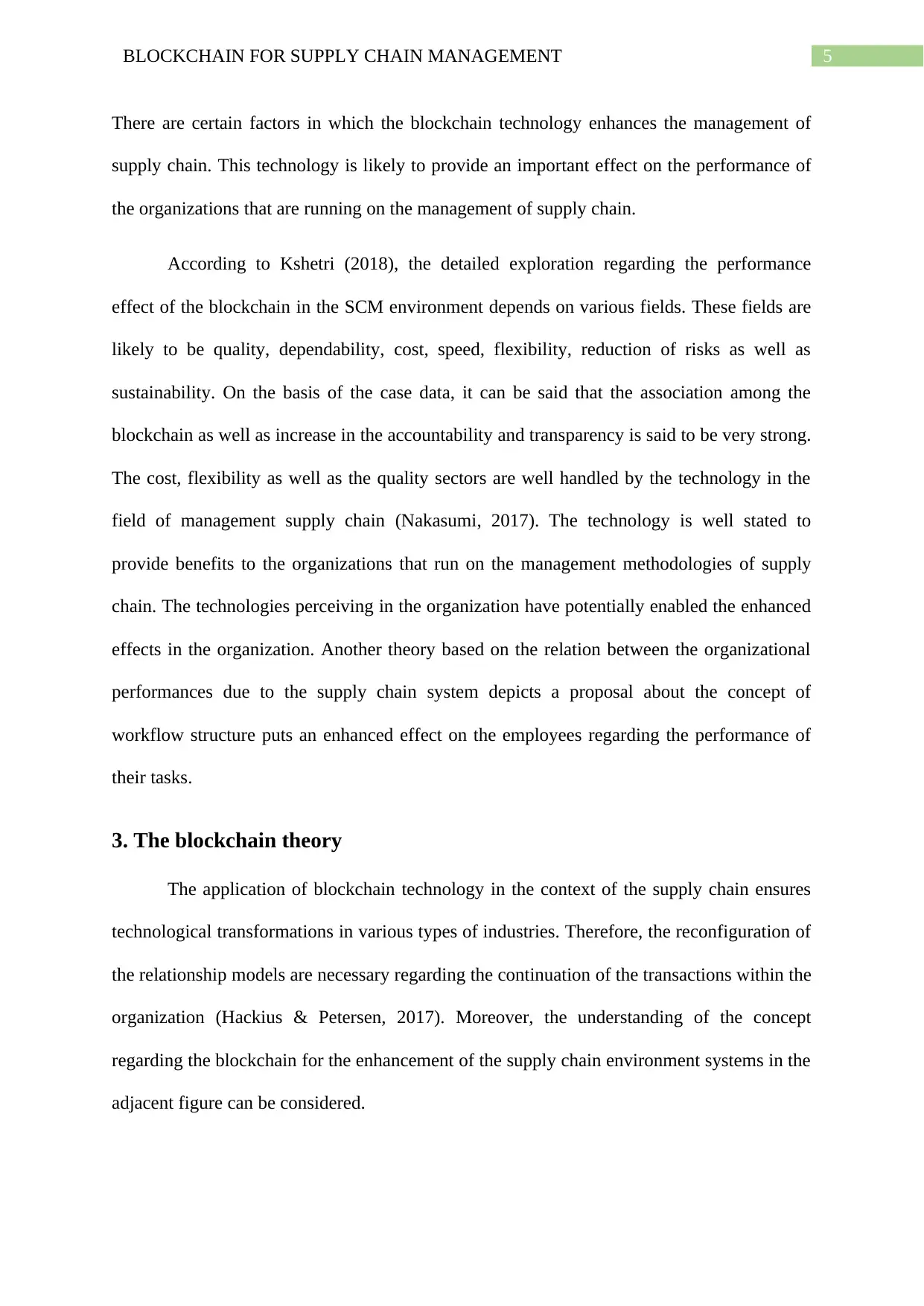
5BLOCKCHAIN FOR SUPPLY CHAIN MANAGEMENT
There are certain factors in which the blockchain technology enhances the management of
supply chain. This technology is likely to provide an important effect on the performance of
the organizations that are running on the management of supply chain.
According to Kshetri (2018), the detailed exploration regarding the performance
effect of the blockchain in the SCM environment depends on various fields. These fields are
likely to be quality, dependability, cost, speed, flexibility, reduction of risks as well as
sustainability. On the basis of the case data, it can be said that the association among the
blockchain as well as increase in the accountability and transparency is said to be very strong.
The cost, flexibility as well as the quality sectors are well handled by the technology in the
field of management supply chain (Nakasumi, 2017). The technology is well stated to
provide benefits to the organizations that run on the management methodologies of supply
chain. The technologies perceiving in the organization have potentially enabled the enhanced
effects in the organization. Another theory based on the relation between the organizational
performances due to the supply chain system depicts a proposal about the concept of
workflow structure puts an enhanced effect on the employees regarding the performance of
their tasks.
3. The blockchain theory
The application of blockchain technology in the context of the supply chain ensures
technological transformations in various types of industries. Therefore, the reconfiguration of
the relationship models are necessary regarding the continuation of the transactions within the
organization (Hackius & Petersen, 2017). Moreover, the understanding of the concept
regarding the blockchain for the enhancement of the supply chain environment systems in the
adjacent figure can be considered.
There are certain factors in which the blockchain technology enhances the management of
supply chain. This technology is likely to provide an important effect on the performance of
the organizations that are running on the management of supply chain.
According to Kshetri (2018), the detailed exploration regarding the performance
effect of the blockchain in the SCM environment depends on various fields. These fields are
likely to be quality, dependability, cost, speed, flexibility, reduction of risks as well as
sustainability. On the basis of the case data, it can be said that the association among the
blockchain as well as increase in the accountability and transparency is said to be very strong.
The cost, flexibility as well as the quality sectors are well handled by the technology in the
field of management supply chain (Nakasumi, 2017). The technology is well stated to
provide benefits to the organizations that run on the management methodologies of supply
chain. The technologies perceiving in the organization have potentially enabled the enhanced
effects in the organization. Another theory based on the relation between the organizational
performances due to the supply chain system depicts a proposal about the concept of
workflow structure puts an enhanced effect on the employees regarding the performance of
their tasks.
3. The blockchain theory
The application of blockchain technology in the context of the supply chain ensures
technological transformations in various types of industries. Therefore, the reconfiguration of
the relationship models are necessary regarding the continuation of the transactions within the
organization (Hackius & Petersen, 2017). Moreover, the understanding of the concept
regarding the blockchain for the enhancement of the supply chain environment systems in the
adjacent figure can be considered.
⊘ This is a preview!⊘
Do you want full access?
Subscribe today to unlock all pages.

Trusted by 1+ million students worldwide
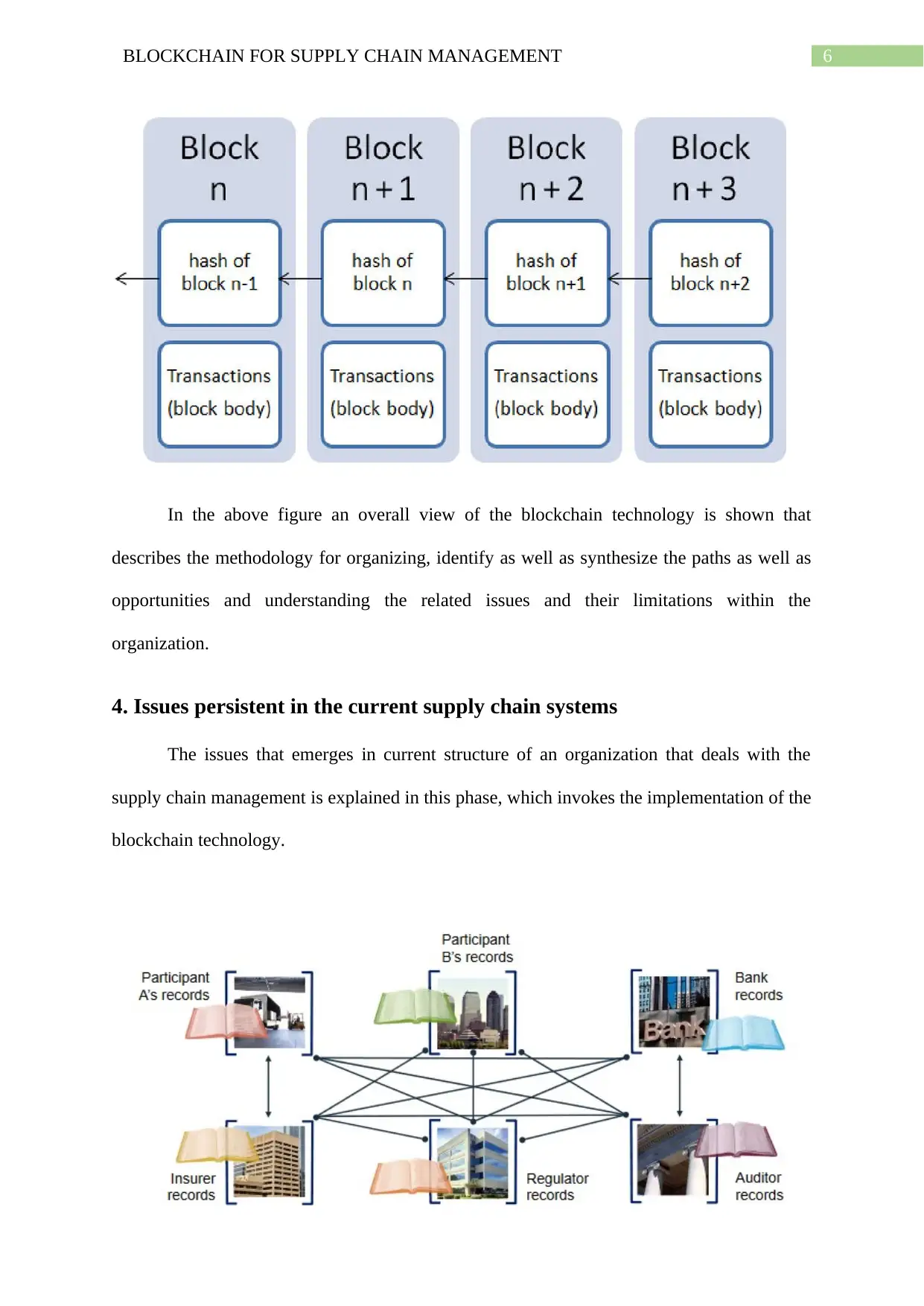
6BLOCKCHAIN FOR SUPPLY CHAIN MANAGEMENT
In the above figure an overall view of the blockchain technology is shown that
describes the methodology for organizing, identify as well as synthesize the paths as well as
opportunities and understanding the related issues and their limitations within the
organization.
4. Issues persistent in the current supply chain systems
The issues that emerges in current structure of an organization that deals with the
supply chain management is explained in this phase, which invokes the implementation of the
blockchain technology.
In the above figure an overall view of the blockchain technology is shown that
describes the methodology for organizing, identify as well as synthesize the paths as well as
opportunities and understanding the related issues and their limitations within the
organization.
4. Issues persistent in the current supply chain systems
The issues that emerges in current structure of an organization that deals with the
supply chain management is explained in this phase, which invokes the implementation of the
blockchain technology.
Paraphrase This Document
Need a fresh take? Get an instant paraphrase of this document with our AI Paraphraser
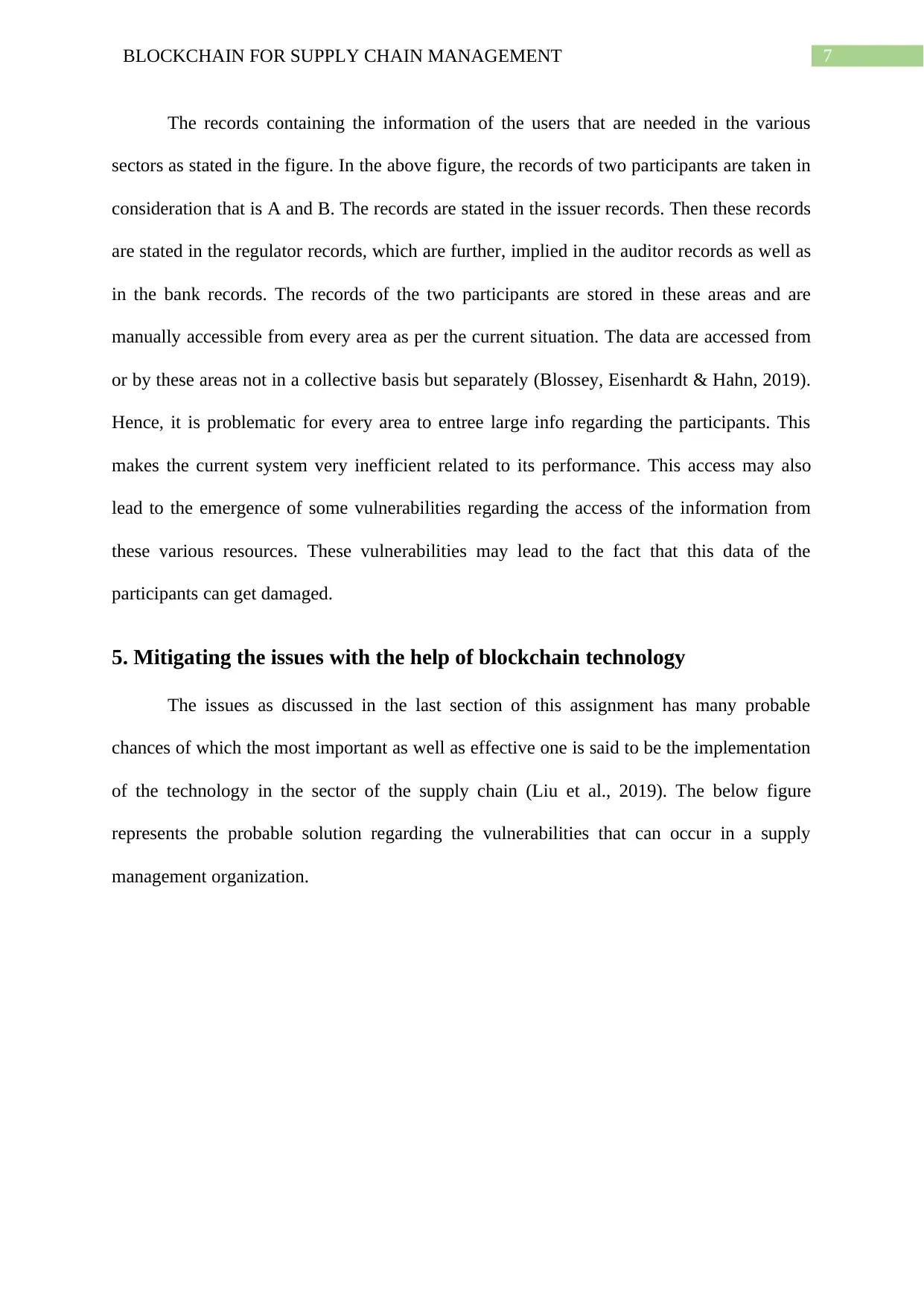
7BLOCKCHAIN FOR SUPPLY CHAIN MANAGEMENT
The records containing the information of the users that are needed in the various
sectors as stated in the figure. In the above figure, the records of two participants are taken in
consideration that is A and B. The records are stated in the issuer records. Then these records
are stated in the regulator records, which are further, implied in the auditor records as well as
in the bank records. The records of the two participants are stored in these areas and are
manually accessible from every area as per the current situation. The data are accessed from
or by these areas not in a collective basis but separately (Blossey, Eisenhardt & Hahn, 2019).
Hence, it is problematic for every area to entree large info regarding the participants. This
makes the current system very inefficient related to its performance. This access may also
lead to the emergence of some vulnerabilities regarding the access of the information from
these various resources. These vulnerabilities may lead to the fact that this data of the
participants can get damaged.
5. Mitigating the issues with the help of blockchain technology
The issues as discussed in the last section of this assignment has many probable
chances of which the most important as well as effective one is said to be the implementation
of the technology in the sector of the supply chain (Liu et al., 2019). The below figure
represents the probable solution regarding the vulnerabilities that can occur in a supply
management organization.
The records containing the information of the users that are needed in the various
sectors as stated in the figure. In the above figure, the records of two participants are taken in
consideration that is A and B. The records are stated in the issuer records. Then these records
are stated in the regulator records, which are further, implied in the auditor records as well as
in the bank records. The records of the two participants are stored in these areas and are
manually accessible from every area as per the current situation. The data are accessed from
or by these areas not in a collective basis but separately (Blossey, Eisenhardt & Hahn, 2019).
Hence, it is problematic for every area to entree large info regarding the participants. This
makes the current system very inefficient related to its performance. This access may also
lead to the emergence of some vulnerabilities regarding the access of the information from
these various resources. These vulnerabilities may lead to the fact that this data of the
participants can get damaged.
5. Mitigating the issues with the help of blockchain technology
The issues as discussed in the last section of this assignment has many probable
chances of which the most important as well as effective one is said to be the implementation
of the technology in the sector of the supply chain (Liu et al., 2019). The below figure
represents the probable solution regarding the vulnerabilities that can occur in a supply
management organization.
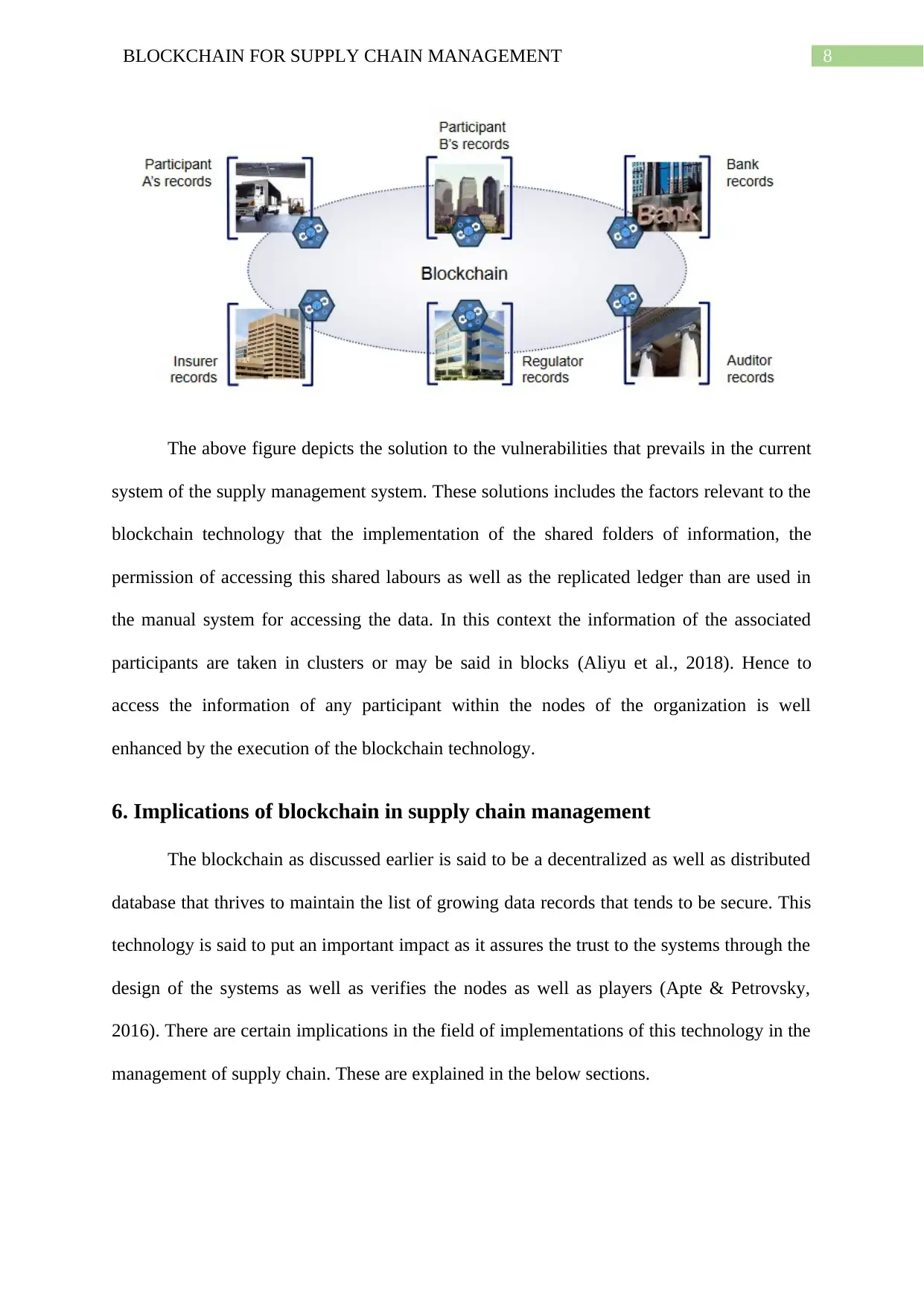
8BLOCKCHAIN FOR SUPPLY CHAIN MANAGEMENT
The above figure depicts the solution to the vulnerabilities that prevails in the current
system of the supply management system. These solutions includes the factors relevant to the
blockchain technology that the implementation of the shared folders of information, the
permission of accessing this shared labours as well as the replicated ledger than are used in
the manual system for accessing the data. In this context the information of the associated
participants are taken in clusters or may be said in blocks (Aliyu et al., 2018). Hence to
access the information of any participant within the nodes of the organization is well
enhanced by the execution of the blockchain technology.
6. Implications of blockchain in supply chain management
The blockchain as discussed earlier is said to be a decentralized as well as distributed
database that thrives to maintain the list of growing data records that tends to be secure. This
technology is said to put an important impact as it assures the trust to the systems through the
design of the systems as well as verifies the nodes as well as players (Apte & Petrovsky,
2016). There are certain implications in the field of implementations of this technology in the
management of supply chain. These are explained in the below sections.
The above figure depicts the solution to the vulnerabilities that prevails in the current
system of the supply management system. These solutions includes the factors relevant to the
blockchain technology that the implementation of the shared folders of information, the
permission of accessing this shared labours as well as the replicated ledger than are used in
the manual system for accessing the data. In this context the information of the associated
participants are taken in clusters or may be said in blocks (Aliyu et al., 2018). Hence to
access the information of any participant within the nodes of the organization is well
enhanced by the execution of the blockchain technology.
6. Implications of blockchain in supply chain management
The blockchain as discussed earlier is said to be a decentralized as well as distributed
database that thrives to maintain the list of growing data records that tends to be secure. This
technology is said to put an important impact as it assures the trust to the systems through the
design of the systems as well as verifies the nodes as well as players (Apte & Petrovsky,
2016). There are certain implications in the field of implementations of this technology in the
management of supply chain. These are explained in the below sections.
⊘ This is a preview!⊘
Do you want full access?
Subscribe today to unlock all pages.

Trusted by 1+ million students worldwide
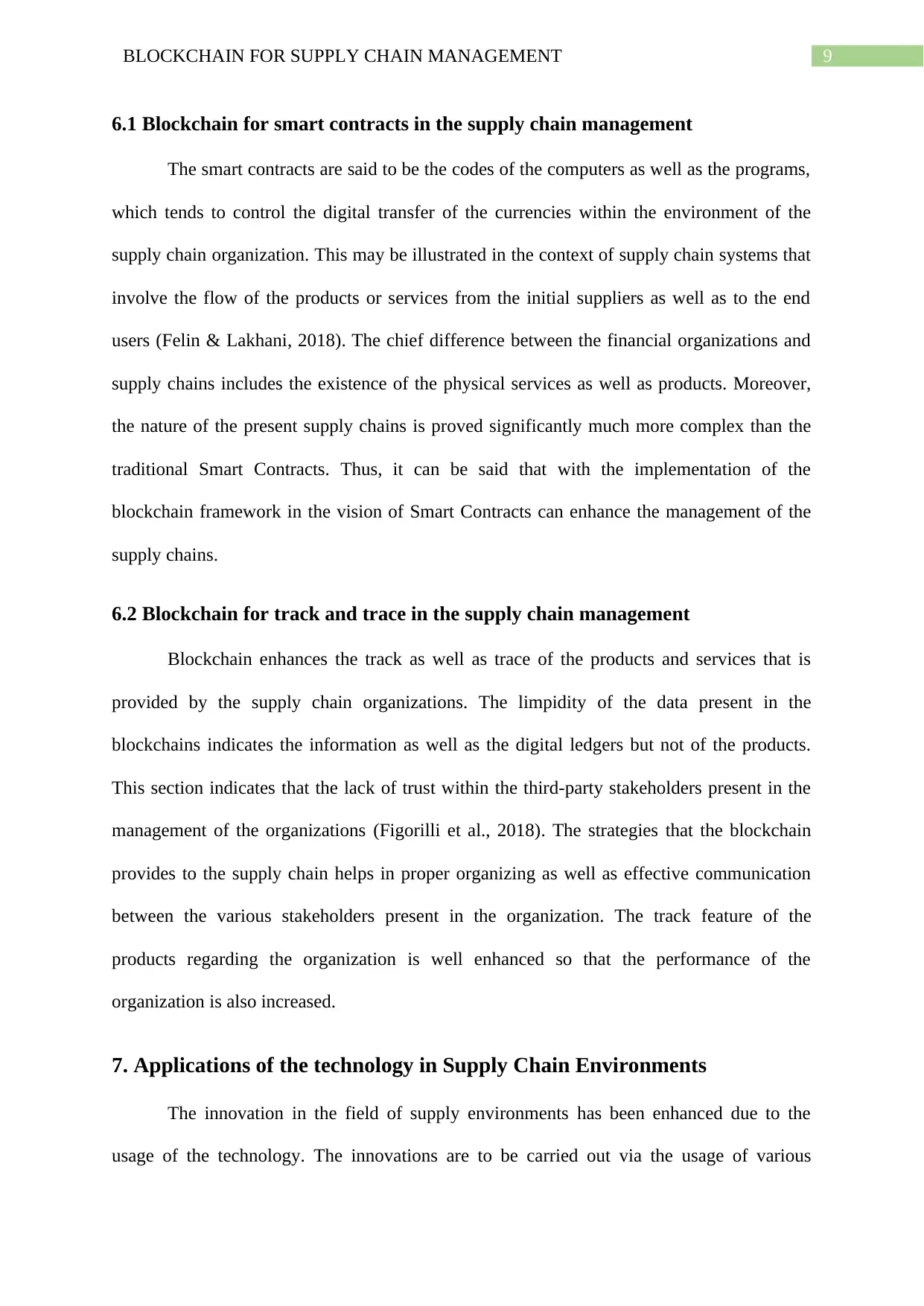
9BLOCKCHAIN FOR SUPPLY CHAIN MANAGEMENT
6.1 Blockchain for smart contracts in the supply chain management
The smart contracts are said to be the codes of the computers as well as the programs,
which tends to control the digital transfer of the currencies within the environment of the
supply chain organization. This may be illustrated in the context of supply chain systems that
involve the flow of the products or services from the initial suppliers as well as to the end
users (Felin & Lakhani, 2018). The chief difference between the financial organizations and
supply chains includes the existence of the physical services as well as products. Moreover,
the nature of the present supply chains is proved significantly much more complex than the
traditional Smart Contracts. Thus, it can be said that with the implementation of the
blockchain framework in the vision of Smart Contracts can enhance the management of the
supply chains.
6.2 Blockchain for track and trace in the supply chain management
Blockchain enhances the track as well as trace of the products and services that is
provided by the supply chain organizations. The limpidity of the data present in the
blockchains indicates the information as well as the digital ledgers but not of the products.
This section indicates that the lack of trust within the third-party stakeholders present in the
management of the organizations (Figorilli et al., 2018). The strategies that the blockchain
provides to the supply chain helps in proper organizing as well as effective communication
between the various stakeholders present in the organization. The track feature of the
products regarding the organization is well enhanced so that the performance of the
organization is also increased.
7. Applications of the technology in Supply Chain Environments
The innovation in the field of supply environments has been enhanced due to the
usage of the technology. The innovations are to be carried out via the usage of various
6.1 Blockchain for smart contracts in the supply chain management
The smart contracts are said to be the codes of the computers as well as the programs,
which tends to control the digital transfer of the currencies within the environment of the
supply chain organization. This may be illustrated in the context of supply chain systems that
involve the flow of the products or services from the initial suppliers as well as to the end
users (Felin & Lakhani, 2018). The chief difference between the financial organizations and
supply chains includes the existence of the physical services as well as products. Moreover,
the nature of the present supply chains is proved significantly much more complex than the
traditional Smart Contracts. Thus, it can be said that with the implementation of the
blockchain framework in the vision of Smart Contracts can enhance the management of the
supply chains.
6.2 Blockchain for track and trace in the supply chain management
Blockchain enhances the track as well as trace of the products and services that is
provided by the supply chain organizations. The limpidity of the data present in the
blockchains indicates the information as well as the digital ledgers but not of the products.
This section indicates that the lack of trust within the third-party stakeholders present in the
management of the organizations (Figorilli et al., 2018). The strategies that the blockchain
provides to the supply chain helps in proper organizing as well as effective communication
between the various stakeholders present in the organization. The track feature of the
products regarding the organization is well enhanced so that the performance of the
organization is also increased.
7. Applications of the technology in Supply Chain Environments
The innovation in the field of supply environments has been enhanced due to the
usage of the technology. The innovations are to be carried out via the usage of various
Paraphrase This Document
Need a fresh take? Get an instant paraphrase of this document with our AI Paraphraser
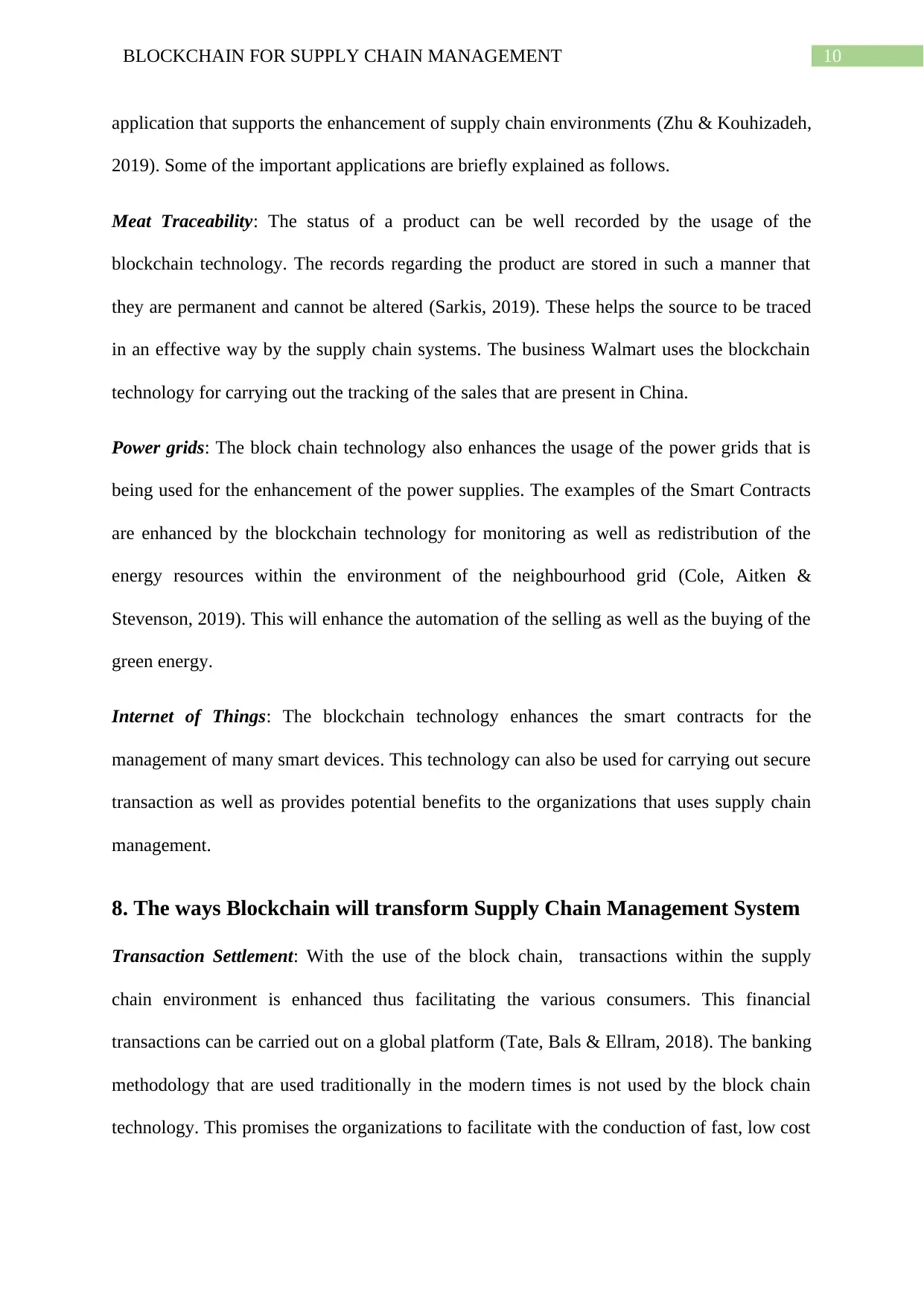
10BLOCKCHAIN FOR SUPPLY CHAIN MANAGEMENT
application that supports the enhancement of supply chain environments (Zhu & Kouhizadeh,
2019). Some of the important applications are briefly explained as follows.
Meat Traceability: The status of a product can be well recorded by the usage of the
blockchain technology. The records regarding the product are stored in such a manner that
they are permanent and cannot be altered (Sarkis, 2019). These helps the source to be traced
in an effective way by the supply chain systems. The business Walmart uses the blockchain
technology for carrying out the tracking of the sales that are present in China.
Power grids: The block chain technology also enhances the usage of the power grids that is
being used for the enhancement of the power supplies. The examples of the Smart Contracts
are enhanced by the blockchain technology for monitoring as well as redistribution of the
energy resources within the environment of the neighbourhood grid (Cole, Aitken &
Stevenson, 2019). This will enhance the automation of the selling as well as the buying of the
green energy.
Internet of Things: The blockchain technology enhances the smart contracts for the
management of many smart devices. This technology can also be used for carrying out secure
transaction as well as provides potential benefits to the organizations that uses supply chain
management.
8. The ways Blockchain will transform Supply Chain Management System
Transaction Settlement: With the use of the block chain, transactions within the supply
chain environment is enhanced thus facilitating the various consumers. This financial
transactions can be carried out on a global platform (Tate, Bals & Ellram, 2018). The banking
methodology that are used traditionally in the modern times is not used by the block chain
technology. This promises the organizations to facilitate with the conduction of fast, low cost
application that supports the enhancement of supply chain environments (Zhu & Kouhizadeh,
2019). Some of the important applications are briefly explained as follows.
Meat Traceability: The status of a product can be well recorded by the usage of the
blockchain technology. The records regarding the product are stored in such a manner that
they are permanent and cannot be altered (Sarkis, 2019). These helps the source to be traced
in an effective way by the supply chain systems. The business Walmart uses the blockchain
technology for carrying out the tracking of the sales that are present in China.
Power grids: The block chain technology also enhances the usage of the power grids that is
being used for the enhancement of the power supplies. The examples of the Smart Contracts
are enhanced by the blockchain technology for monitoring as well as redistribution of the
energy resources within the environment of the neighbourhood grid (Cole, Aitken &
Stevenson, 2019). This will enhance the automation of the selling as well as the buying of the
green energy.
Internet of Things: The blockchain technology enhances the smart contracts for the
management of many smart devices. This technology can also be used for carrying out secure
transaction as well as provides potential benefits to the organizations that uses supply chain
management.
8. The ways Blockchain will transform Supply Chain Management System
Transaction Settlement: With the use of the block chain, transactions within the supply
chain environment is enhanced thus facilitating the various consumers. This financial
transactions can be carried out on a global platform (Tate, Bals & Ellram, 2018). The banking
methodology that are used traditionally in the modern times is not used by the block chain
technology. This promises the organizations to facilitate with the conduction of fast, low cost
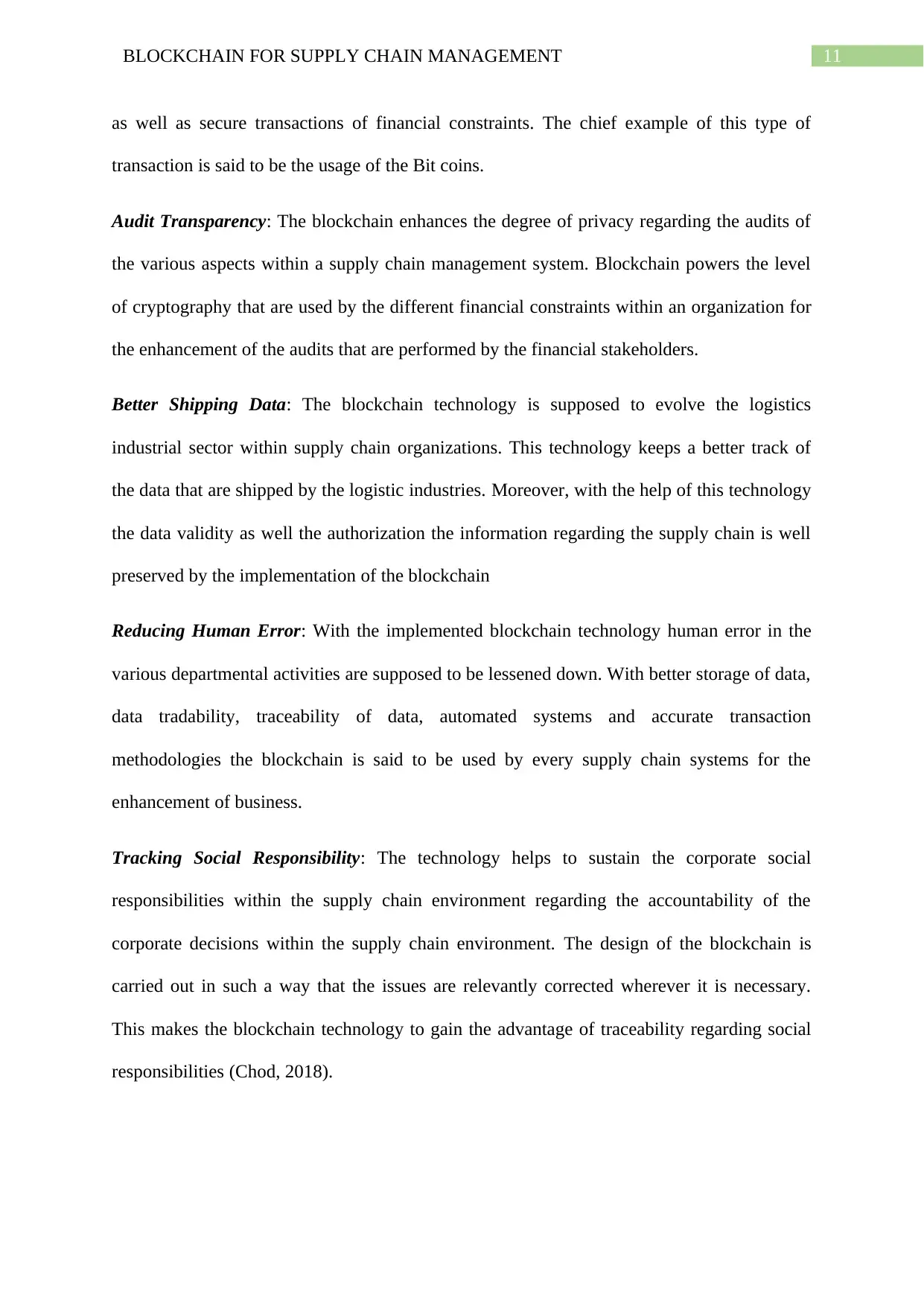
11BLOCKCHAIN FOR SUPPLY CHAIN MANAGEMENT
as well as secure transactions of financial constraints. The chief example of this type of
transaction is said to be the usage of the Bit coins.
Audit Transparency: The blockchain enhances the degree of privacy regarding the audits of
the various aspects within a supply chain management system. Blockchain powers the level
of cryptography that are used by the different financial constraints within an organization for
the enhancement of the audits that are performed by the financial stakeholders.
Better Shipping Data: The blockchain technology is supposed to evolve the logistics
industrial sector within supply chain organizations. This technology keeps a better track of
the data that are shipped by the logistic industries. Moreover, with the help of this technology
the data validity as well the authorization the information regarding the supply chain is well
preserved by the implementation of the blockchain
Reducing Human Error: With the implemented blockchain technology human error in the
various departmental activities are supposed to be lessened down. With better storage of data,
data tradability, traceability of data, automated systems and accurate transaction
methodologies the blockchain is said to be used by every supply chain systems for the
enhancement of business.
Tracking Social Responsibility: The technology helps to sustain the corporate social
responsibilities within the supply chain environment regarding the accountability of the
corporate decisions within the supply chain environment. The design of the blockchain is
carried out in such a way that the issues are relevantly corrected wherever it is necessary.
This makes the blockchain technology to gain the advantage of traceability regarding social
responsibilities (Chod, 2018).
as well as secure transactions of financial constraints. The chief example of this type of
transaction is said to be the usage of the Bit coins.
Audit Transparency: The blockchain enhances the degree of privacy regarding the audits of
the various aspects within a supply chain management system. Blockchain powers the level
of cryptography that are used by the different financial constraints within an organization for
the enhancement of the audits that are performed by the financial stakeholders.
Better Shipping Data: The blockchain technology is supposed to evolve the logistics
industrial sector within supply chain organizations. This technology keeps a better track of
the data that are shipped by the logistic industries. Moreover, with the help of this technology
the data validity as well the authorization the information regarding the supply chain is well
preserved by the implementation of the blockchain
Reducing Human Error: With the implemented blockchain technology human error in the
various departmental activities are supposed to be lessened down. With better storage of data,
data tradability, traceability of data, automated systems and accurate transaction
methodologies the blockchain is said to be used by every supply chain systems for the
enhancement of business.
Tracking Social Responsibility: The technology helps to sustain the corporate social
responsibilities within the supply chain environment regarding the accountability of the
corporate decisions within the supply chain environment. The design of the blockchain is
carried out in such a way that the issues are relevantly corrected wherever it is necessary.
This makes the blockchain technology to gain the advantage of traceability regarding social
responsibilities (Chod, 2018).
⊘ This is a preview!⊘
Do you want full access?
Subscribe today to unlock all pages.

Trusted by 1+ million students worldwide
1 out of 19
Related Documents
Your All-in-One AI-Powered Toolkit for Academic Success.
+13062052269
info@desklib.com
Available 24*7 on WhatsApp / Email
![[object Object]](/_next/static/media/star-bottom.7253800d.svg)
Unlock your academic potential
Copyright © 2020–2025 A2Z Services. All Rights Reserved. Developed and managed by ZUCOL.





